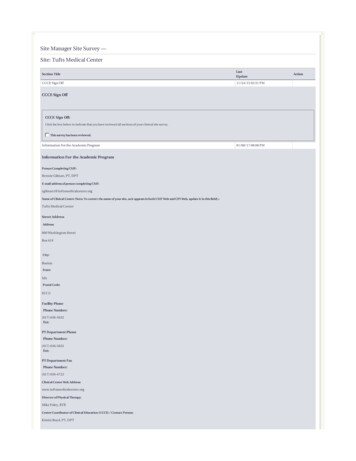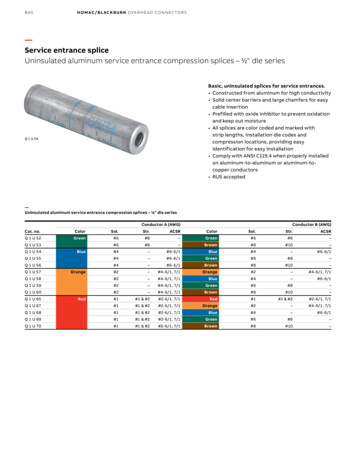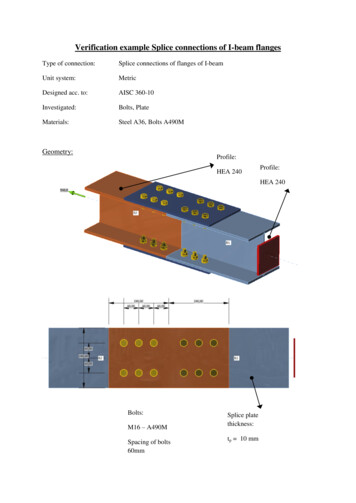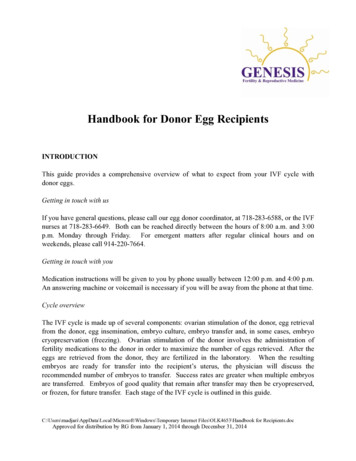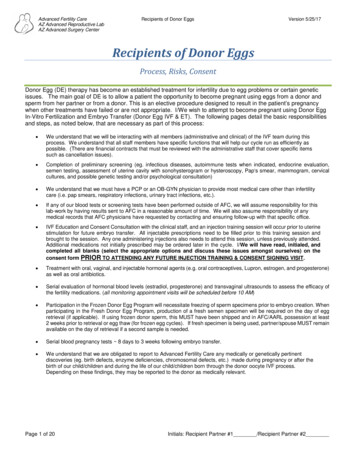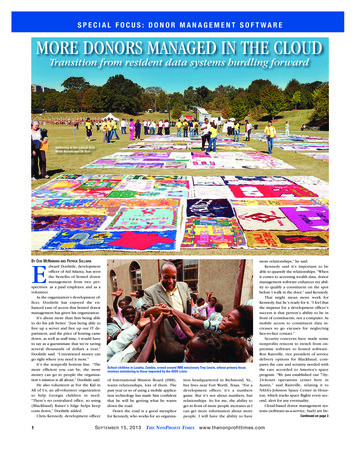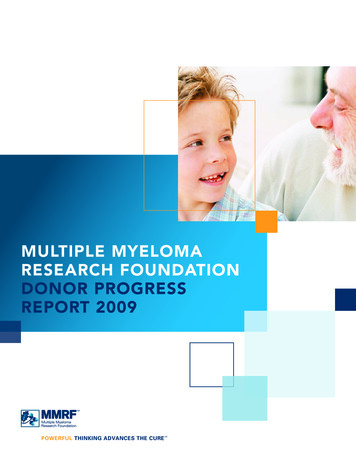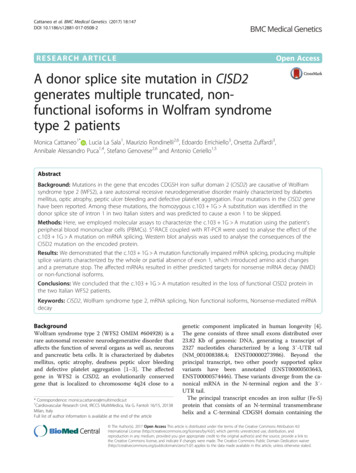
Transcription
Cattaneo et al. BMC Medical Genetics (2017) 18:147DOI 10.1186/s12881-017-0508-2RESEARCH ARTICLEOpen AccessA donor splice site mutation in CISD2generates multiple truncated, nonfunctional isoforms in Wolfram syndrometype 2 patientsMonica Cattaneo1* , Lucia La Sala1, Maurizio Rondinelli2,6, Edoardo Errichiello3, Orsetta Zuffardi3,Annibale Alessandro Puca1,4, Stefano Genovese2,6 and Antonio Ceriello1,5AbstractBackground: Mutations in the gene that encodes CDGSH iron sulfur domain 2 (CISD2) are causative of Wolframsyndrome type 2 (WFS2), a rare autosomal recessive neurodegenerative disorder mainly characterized by diabetesmellitus, optic atrophy, peptic ulcer bleeding and defective platelet aggregation. Four mutations in the CISD2 genehave been reported. Among these mutations, the homozygous c.103 1G A substitution was identified in thedonor splice site of intron 1 in two Italian sisters and was predicted to cause a exon 1 to be skipped.Methods: Here, we employed molecular assays to characterize the c.103 1G A mutation using the patient’speripheral blood mononuclear cells (PBMCs). 5′-RACE coupled with RT-PCR were used to analyse the effect of thec.103 1G A mutation on mRNA splicing. Western blot analysis was used to analyse the consequences of theCISD2 mutation on the encoded protein.Results: We demonstrated that the c.103 1G A mutation functionally impaired mRNA splicing, producing multiplesplice variants characterized by the whole or partial absence of exon 1, which introduced amino acid changesand a premature stop. The affected mRNAs resulted in either predicted targets for nonsense mRNA decay (NMD)or non-functional isoforms.Conclusions: We concluded that the c.103 1G A mutation resulted in the loss of functional CISD2 protein inthe two Italian WFS2 patients.Keywords: CISD2, Wolfram syndrome type 2, mRNA splicing, Non functional isoforms, Nonsense-mediated mRNAdecayBackgroundWolfram syndrome type 2 (WFS2 OMIM #604928) is arare autosomal recessive neurodegenerative disorder thataffects the function of several organs as well as, neuronsand pancreatic beta cells. It is characterized by diabetesmellitus, optic atrophy, deafness peptic ulcer bleedingand defective platelet aggregation [1–3]. The affectedgene in WFS2 is CISD2, an evolutionarily conservedgene that is localized to chromosome 4q24 close to a* Correspondence: monica.cattaneo@multimedica.it1Cardiovascular Research Unit, IRCCS MultiMedica, Via G. Fantoli 16/15, 20138Milan, ItalyFull list of author information is available at the end of the articlegenetic component implicated in human longevity [4].The gene consists of three small exons distributed over23.82 Kb of genomic DNA, generating a transcript of2327 nucleotides characterized by a long 3′-UTR tail(NM 001008388.4; ENST00000273986). Beyond theprincipal transcript, two other poorly supported splicevariants have been annotated (ENST00000503643,ENST00000574446). These variants diverge from the canonical mRNA in the N-terminal region and the 3′UTR tail.The principal transcript encodes an iron sulfur (Fe-S)protein that consists of an N-terminal transmembranehelix and a C-terminal CDGSH domain containing the The Author(s). 2017 Open Access This article is distributed under the terms of the Creative Commons Attribution 4.0International License (http://creativecommons.org/licenses/by/4.0/), which permits unrestricted use, distribution, andreproduction in any medium, provided you give appropriate credit to the original author(s) and the source, provide a link tothe Creative Commons license, and indicate if changes were made. The Creative Commons Public Domain Dedication o/1.0/) applies to the data made available in this article, unless otherwise stated.
Cattaneo et al. BMC Medical Genetics (2017) 18:147Fe-S cluster [5]. It displays a dynamic subcellularlocalization between the endoplasmic reticulum (ER)and mitochondrial membranes, and is specificallyenriched in the mitochondrial outer membrane (MOM)and the mitochondria-associated ER membranes(MAMs) [6]. The exact function of the CISD2 protein isstill unknown but it is reported to be an iron donatingprotein, that can transfer iron to the mitochondria in living cells, and to have a crucial role in the regulation ofiron and reactive oxygen species (ROS) as well as in preserving and maintaining mitochondrial homeostasis [7].Indeed, the downmodulation of CISD2 in several celllines resulted in decreased mitochondrial function andintegrity as well as the activation of autophagy and apoptosis [8–10]. The mouse Cisd2 knockout, which is anavailable disease model that recapitulates several clinicalmanifestations of WFS2, further emphasized the association of CISD2 function with mitochondrial integrityand homeostasis, establishing WFS2 as a mitochondrialmediated disorder [11]. Mitochondrial breakdown anddysfunction are reported to be the early promoters ofpremature ageing and autophagic cell death in deficientmice [11].To date, four cases of WFS2 with mutations in CISD2have been reported: i. a homozygous missense mutationidentified in three consanguineous families of Jordaniandescent, located close to the intron-exon junction ofexon 2, that affects mRNA splicing and causes a truncated non-functional protein [1]; ii. a homozygous intragenic deletion affecting the entirety of exon 2 in aEuropean Caucasian girl [2]; iii. a homozygous mutation(NM 001008388.4:c.103 1G A) in the donor splicesite of intron 1 that was predicted to cause exon 1 to beskipped identified in two Italian siblings [3]; and iv. ahomozygous missense variant located in exon 2 that ispredicted to induce a conformational change of theCISD2 homodimeric protein model and to alter theredox and functional properties of the protein in a Moroccan patient [12].Here, we report the molecular and biochemicalcharacterization of the c.103 1G A mutation usingperipheral blood mononuclear cells (PMBCs) isolatedfrom the affected siblings and unaffected parents. Theresults provide mechanistic insight into the effect of themutation on the CISD2 splicing pattern and on themRNA and protein levels.MethodsPeripheral blood mononuclear blood cells isolationPBMCs were isolated from the whole venous blood of thehealthy donator, patients and parents by density gradientcentrifugation using Histopaque (Sigma-Aldrich, Milan,Italy), according to the manufacturer’s instructions. WrittenPage 2 of 8informed consent was obtained from all subjects enrolledin the study.RNA extraction, RT-PCR and quantitative real-time PCRTotal RNA was extracted using miRNeasy mini Kit(Qiagen, Milan Italy) and reverse transcribed withSuperscript III reverse transcriptase (Invitrogen, Milan,Italy), according to manufacturer’s instructions.Semi-quantitative PCR amplifications were performedusing GoTaq DNA Polymerase (Promega, Milan, Italy).The PCR conditions were: denaturation at 95 C for2 min, followed by 24 (for actin B, ActB) and 35 (forCISD2) cycles at 95 C for 30 s, 60 C for 40 s, and 72 Cfor 60 s.Quantitative real-time PCR was performed in triplicateusing ABI 7900 HT thermo cycler and SYBR Green PCRMaster mix (Applied Biosystems, Life Technology,Monza, Italy). Data were normalized to ActB expressionusing the delta Ct method.Primer Sequences:ex1-F: 5′-gtccctgaaagcattaccgg-3′ex2-F: 5′-cagaatggcttcggttattg-3′ex2int-F: 5′-tcctcccgaagaagaaacaaca 3′ex2–3-F: 5′-gttctaaaacgtttcctgcc-3′3′-utr-R: 5′-cattccaccccagctgtcac-3′Ex3-R: 5′- tatgtgaaccatcgcaggca-3′ActB-F: 5′-cagccatgtacgttgctatccagg-3ActB-R: 5′-aggtccagacgcaggatggcatg 3′Rapid amplification of 5′ cDNA ends (5′-RACE)The SMARTer RACE cDNA Amplification kit (Clontech,California, USA) was used to extend the CISD2 mRNA inthe PBMCs from the patients, according to the manufacturer’s instructions. The synthesis of the first strandcDNA was carried out with total RNA (1 μg) using a 5′CDS primer A, SMART II A oligonucleotide andSMARTScribe Reverse Transcriptase. The 5′-RACE PCRreaction was performed with the high fidelity enzyme(SeqAmp DNA polymerase, Clontech) using a universalprimer A mix (UPM, forward primer) and an antisensegene specific primer (GSP1) designed against the exon 3of the CISD2. The nested 5′-RACE PCR was carried outusing a specific reverse primers (GSP2) designed inner tothe exon 3 of CISD2. The primer sequences are notedbelow (the bold sequences referred to the 15 nucleotidesoverlapped withpUC19 vector suitable for the in fusioncloning). The 5′-RACE products were separated by 2%agarose gel electrophoresis and the resulting bands wereextracted from the gel, purified using NucleoSpin gel-PCRClean Up Kit (Clontech), and cloned into pUC19. Thepositive clones that contained the inserts of the expectedsize were screened by colony PCR using M13F and M13Rprimers and sequenced by the Sanger method (BigDye
Cattaneo et al. BMC Medical Genetics (2017) 18:147Terminator v 3.1) and 3730XL DNA Analyzer (AppliedBiosystems).Primer Sequences:GSP1: GSP2: M13-F: 5′-gtaaaacgacggccagt-3′M13-R: 5′-caggaaacagctatgac-3′SNP genotypingThe genomic DNA was isolated from buccal swab usingQiAamp DNA Mini Kit (Qiagen, Milan, Italy). The genomic region flanking SNP was amplified with the high fidelity enzyme (SeqAmp DNA polymerase, Clontech)using primers noted below. The PCR products were sequenced by the Sanger method (BigDye Terminator v3.1) and 3730XL DNA Analyzer (Applied Biosystems).Primer sequences:SNP-F: 5′-gcagtccgccgcgagcgtac-3′SNP-R: 5′-ccggtaatgctttcagggac-3′Western blotPBMCs were lysed in 50 mM Tris HCl (PH 7.6),150 mM NaCl, 1% Nonidet P-40 containing proteaseand phosphatase inhibitor cocktail (Sigma). The proteinconcentration was determined by Bradford assay(Thermo Scientific, Milan, Italy). The total proteins wereresolved on 14% SDS-Polyacrylamide gel, blotted ontoPVDF membrane (GE Healthcare, Euroclone, Pero,Milan, Italy), and probed with the antibodies anti-CISD2(1:1000, Proteintech, LaboSpace Srl, Milan, Italy) and βtubulin (1:2000, Sigma). Proteins were detected withanti-rabbit secondary antibodies (1:100,000, GE Healthcare) and anti-mouse (1:10,000, GE Healthcare). Filterswere developed with western Sure premium Chemiluminescent Substrate LI-COR using LI-COR instrument.β tubulin was used as normalizer.Statistical analysesStatistically significant differences between samples weredetermined in all the experiments by one-way ANOVAanalyses; *, **, *** and **** indicated p 0.05, p 0.01 andp 0.001, p 0,0001, respectively. A p value 0.05 wasconsidered statistically significant.ResultsMolecular analysis of CISD2 mRNA in PBMCsIt was previously predicted that a homozygous CISD2mutation in the donor splice site of intron 1(NM 001008388.4:c.103 1G A) caused exon 1 to beskipped in two Italian sisters affected by WFS2 [3]. Toanalyse the effect of the c.103 1G A mutation on themRNA, a reverse transcription polymerase chainPage 3 of 8reaction (RT-PCR) assay covering almost the entirecDNA was performed on RNA extracted from PMBCsderived from the patients (1 and 2) and the heterozygousunaffected parents (3 and 4), respectively. The PBMCsderived from healthy donor were also included as a control (CTR). Overlapping primers designed against eachof the three exons of the CISD2 gene were coupled withtwo primers designed against the 3′-UTR and exon 3,allowing for the dissection of four fragments representing progressive 5′ deletions (Fig. 1a and b). The primersdesigned against exons 2 and 3 amplified the expectedPCR products of 991 and 790 nt in all samples, althoughvery faint levels were detected in the patients (Fig. 1c).As predicted, no amplification was observed in patientsusing the primers to amplify the CISD2 region fromexon 1 to exon 3, while PCR products of the expectedsize (1031 and 227 nt) were obtained in the remainingsamples (Fig. 1c). The quantitative PCR analysis performed with the primer set designed against exons 2 and3, confirmed the reduced amounts of CISD2 mRNAamplified in the patients compared with those obtainedin either the parents or the healthy control (less than99%) (Fig. 1d), suggesting the strong instability of themutant mRNA. A decrease in mRNA levels of approximately 64% was also observed in the heterozygous samples compared to the mRNA levels of the control(Fig. 1d). Finally, the primer set designed to amplify exon1 validated a decrease of CISD2 mRNA of approximately65% in the parents and undetectable signals in thehomozygous samples (Fig. 1d).Together, the results indicate a potential skipping ofexon 1 in the transcripts of the patients, which severelyaffects the mRNA stability.Identification of multiple CISD2 isoforms by 5′-RACETo validate the putative exon 1 absence demonstratedby RT-PCR, a 5′-RACE experiment was performed ontotal RNA derived from PBMCs of the patients and thehealthy control. A gene-specific primer (GSP1) designedagainst exon 3 and a forward universal primer (UPM)were used for the PCR step that followed the cDNA synthesis in the 5′-RACE process. The expected PCR product of approximately 500 nt was extended in the healthycontrol, while smeared signals were detected in bothhomozygous samples, reinforcing the very low amountof mutant mRNA (data not shown). To increase specificity and sensitivity, a nested PCR with an inner GSP2primer was performed on the primary PCR productswhich resulted in the extension of two fragments in bothpatients: one of approximately 400 nt in size, which wasthe more represented fragment, and one of 800–900 nt,which was less enriched (Fig. 2a).The PCR products were cloned, and several independent clones were screened based on their molecular
Cattaneo et al. BMC Medical Genetics (2017) 18:147Page 4 of 8Fig. 1 Molecular characterization of the homozygous and heterozygous CISD2 transcript. a A schematic representation of the CISD2 transcript: thearrows represent the PCR primers, and four overlapping sets of CISD2 primers were used. The lines indicate the expected sizes of the PCR productsusing the specific set of primers. b The nucleotide sequence of CISD2 cDNA with exons in uppercase letters and alternate colours, the 5′-UTRand 3′-UTR in lowercase letters, and the ATG in bold letters. The arrows indicate the PCR primers used for the characterization of the CISD2transcript. c RT-PCR analysis performed on PBMCs derived from a healthy individual (CTR), homozygous probands (1 and 2) and heterozygousunaffected parents (3 and 4). ActB was used as a loading control, and a negative PCR control (b) was included to test possible contamination.The data indicate a putative skipping of the N-terminus of CISD2 in patients and suggest a strong instability of mutant CISD2 mRNA. d mRNAquantitative real-time PCR. A schematic representation of the CISD2 transcript shows the PCR primers used for the analysis. The CISD2 mRNAlevel drastically decreased in the homozygous samples, compared to that in the healthy PBMCs. The histograms show values normalized relative to ahousekeeping gene (ActB) and expressed as a fold modulation compared to the healthy control. The error bars represent the mean SEM for threeexperiments. Ordinary one-way ANOVA, *P 0,05, **P 0,01, ***P 0,001 and ****P 0,0001length. A direct sequencing analysis performed on tendifferent clones for each patient showed that the 400-ntproduct contained three different transcripts resultingfrom the whole or partial absence of exon 1 from themature transcript. One product consisted of exon 2 perfectly spliced with exon 3 joined to a short stretch ofgenomic DNA sequence (86 nucleotides in size) located57,022 nt upstream of the beginning of exon 2 (Fig. 2b,a1). Computer analysis indicated that this small segmentof genomic DNA (Chr4:102,828,100–102,828,185, coordinates referred to GRCh38/hg38 of the human genome assembly, www.genome.ucsc.edu) was located within an CpGisland (CpG:141, chr4:102,826,475 102,828,235) and partially overlapped with the pugo gene (Chr4:102,827,193–102,829,052) (Additional file 1: Figure S1). There is noNCBI RefSeq model for the pugo gene, but Homo sapiens cDNA sequences in GenBank that were alignedon the genome and clustered in a minimal nonredundant way by the manually supervised AceViewprogram t two unspliced and three alternatively spliced variants. Among these variants, the unspliced pugo variant a,which is the only variant that putatively encodes a protein(DA090506 and DB032576), matched 86 nt of its noncoding region with the CISD2 variant a1.The second transcript, where exon 2 correctly splicedwith exon 3, was joined to a short stretch of genomicDNA sequence (83 nucleotides in size) located at 24004nucleotides upstream the beginning of exon 2 (Fig. 2b,a2). Computer analysis performed on this small segmentof genomic DNA (Chr4:102,861,131–102,861,212) didnot identify the existence of any genes. In both variants,in silico analysis (NetStart1, http://www.cbs.dtu.dk) predicted a translational start site in the beginning of exon 2which resulted in a frame shift, introducing amino acidschanges and a premature stop codon (Fig. 2c, a1 and a2).Finally, the third 5′-RACE product resulted in the exclusion of the last 70 bases of exon 1 from the mature
Cattaneo et al. BMC Medical Genetics (2017) 18:147Page 5 of 8Fig. 2 Multiple truncated and non functional CISD2 isoforms. a The 5′-RACE extended an expected 500 nt PCR product in the healthy controland two products of approximately 400 and 800–900 bases in the probands. b A schematic representation of the exon structure of wild-type (a)and mutant (a1-a3) CISD2 variants, and putative pre-mRNAs (b1 and b2). The homozygous mutation in the donor splice of intron 1 generatedmultiple transcripts characterized by the whole or partial absence of exon 1 (a1-a3) and inefficiently spliced pre-mRNAs retaining a large segmentof intron 1 (b1 and b2). c The sequencing resulting from the 400 nt 5′-RACE products. The cDNA and amino acids sequences are shown. The exonsare indicated in uppercase letters and alternate colours. The 5′-UTR is indicated in black lowercase letters. a1 and a2: Short stretches of genomic DNAare joined to exon 2 perfectly spliced with exon 3. Genomic coordinates: Chr4:102,828,100–102,828,185 and Chr4:102,861,131–102,861,212, for a1 anda2 respectively. CpG island coordinates: Chr4:102,826,475–102,828,235. Pugo gene: Chr4:102,827,193–102,829,052. The ATG, predicted in the beginningof exon 2 (Chr4:102,885,223; NG 008636.2:21,246), shifted the open reading frame and introduced a downstream amino acid changes (underscored) inaddition to premature stop. a3: The partial absence of exon 1 (Chr4:102,869,118–102,869,187; NG 008636.2:5141–5210) caused a frame shift, aminoacids changes (underscored) and a premature stop. The transcriptional start sites are in bold letters and underscored, and they are located at 111 and43 nt upstream the ATG for patient 1 and 2, respectively (position at 4997 and 5064 referred to NG 008636.2; position at 102868974 and 102,869,041referred to Chr4). The SNP rs223332 (NG 008636.2: g.5052G T) is indicated in red and lowercase letter. d The frequency of mutant isoforms inWFS2 patientstranscript (Chr4:102,869,118–102,869,187; NG 008636.2:5141–5210), which shifted the open reading frame andintroduced downstream amino acid changes in addition toa premature stop (Fig. 2b, a3 and c, a3). In this isoform,the transcriptional start site was mapped at 111 and 43 ntupstream of the ATG for patients 1 and 2 respectively(Fig. 2c, a3). The frequency of the mutant isoforms in eachpatient is reported in Fig. 2d. The coexistence of multiplemutant CISD2 variants that diverged from one another byonly the N-terminal region is also demonstrated by the sequence chromatograms from the 5′-RACE products thatwere not subcloned: the region spanning from exon 2 toexon 3 is represented by a single peak pattern,
SMARTScribe Reverse Transcriptase. The 5′-RACE PCR reaction was performed with the high fidelity enzyme (SeqAmp DNA polymerase, Clontech) using a universal primer A mix (UPM, forward primer) and an antisense gene specific primer (GSP1) designed against the ex
